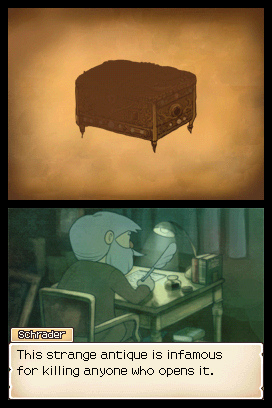Professor Layton And Pandoras Box review
Review of Professor Layton And Pandoras Box video game for the Nintendo DS rated 9 out of 10
Tagged with: DS Puzzler, Professor Layton
Reviewed on by Gamesweasel
If you’ve got a Nintendo DS then you’ll almost certainly already be familiar with Professor Layton, and if you’re not, the chances are you’ll have a friend or relative who is. You may even be one of those many, many people who, last December, spent the weeks in the run-up to Christmas scouring shops both online and off in search of what turned out to be one of the most wanted (and, seemingly, least available) gift items of that year - 2009’s Furby no less - the rather excellent Professor Layton And The Curious Village. On the subject of Christmas shopping, let me give a word of warning here - should you be trying to get the new Professor Layton adventure for your loved one this Christmas, don’t make the mistake I made last year when I was trying to get Professor Layton And The Curious Village for my other half. Finding that it was out of stock EVERYWHERE, and not having the time or the determination to camp outside GAME 24-hours-a-day on the off-chance that they might get a new delivery of stock in, I instead naively ordered a copy from a Hong Kong-based website that claimed, just three weeks before the big day, to have copies of the game in stock, and guaranteed delivery by Christmas Eve. I failed to read the small print that stated that ‘delivery dates might be changed, no refunds once order taken’ and so needless to say, barely had I parted with my cash than I received an email telling me that in fact the game wouldn’t be delivered till February of the following year (and in the end, the game arrived mid-March!) The moral of the story? Don’t believe everything you read on too-good-to-be-true foreign websites - stick with reputable, reliable online stores like Amazon!
Anyway, I digress - you don’t want to hear about my shopping woes, do you, you want to hear about the sequel to one of the biggest Nintendo DS games of last year, right? Well, after unlocking the mysteries of the Curious Village and its unusual inhabitants back in 2008, Professor Layton, along with his plucky sidekick Luke, are now in England on the trail of a mysterious box. Well… it’s ‘mysterious’ to them - for the player there’s a small clue as to what the box might be in the title of the game! Called Professor Layton And The Diabolical Box in the US, for the UK market the game has been renamed Professor Layton And Pandora’s Box, a title that very possibly spoils one of the game’s big plot-twists. Title aside though, the gameplay is unchanged from the US version.
Our story begins with the Professor and Luke receiving a letter from one of Layton’s friends, an academic called Dr Andrew Schrader who states that he has got his hands on a strange antique called the ‘Elysian Box’, an item which is reputed to have killed everyone who has ever opened it! Dr Schrader ends his letter by saying that he was originally intending to not to open the Elysian Box until he had fully researched it, but then just decided ‘to open it anyway’. Which is basically the equivalent of a bomb disposal expert saying ‘I WAS going to check the manual to see which wire to cut’, but then I just thought ‘what the heck, let’s cut all of them!’’ Needless to say, the Professor’s friend doesn’t last long, and no sooner has he popped his clogs than Layton and Luke are setting out to solve the mystery of how Dr Schrader died, and what happened to the box, which has vanished from Schrader’s apartment.
Storyline aside, players of the first game will feel very much at home here. As with the first title, you must guide the Professor and Luke through the twists and turns of the story by using the stylus and touch screen to explore and examine the different environments. Tapping on different objects on the screen often brings up comments and observations from the Professor or Luke, uncovers hidden ‘Hint coins’, and - most importantly - opens up puzzles. These puzzles are essentially the backbone of the game, and come in a variety of forms, some mathematics problems, some logic puzzles, some ‘physical’ tests where you must use the stylus to manipulate objects on screen in some way. Some of these puzzles must be solved in order for you to progress through the game, some give you bonuses if you complete them, and some are there just for fun, and they range in difficulty from fairly easy to actually quite taxing. As before, should a puzzle prove a little tough, then up to three Hint coins can be used to purchase tips on how to solve the puzzle.
The puzzle segment itself has been slightly tweaked since the last game - as before you’re given a written explanation of the task at hand on the top screen (which it is essential to read carefully as often the clue is written in such a way as to deliberately mislead anyone who’s not fully paying attention) but what’s new for the sequel is the ‘Memo’ option. Clicking this button drops what amounts to a piece of digital tracing paper over the top of the puzzle, so you can still see it, but you can then scribble notes, do calculations, and generally figure things out before selecting your answer. In the previous game some of the puzzles offered an option a bit like this, but others didn’t, forcing you to do all the working out in your head, so the Memo option is definitely a welcome addition, and shows that even though Professor Layton And The Curious Village was a first-class game, the developers have still been looking for ways of improving upon it.
There are a few other small differences between this game and the first (like the Hamster minigame for example, where you must collect objects as you explore and then place them on a chess board in such a way that a fat hamster gets some exercise - actually as weird as it sounds, but no less enjoyable for it) but in the main the basic gameplay is more-or-less the same. This means that if you liked the last game, then you’re going to like this. It also means, however, that if you DIDN’T enjoy the last title, then there’s probably not a lot to excite you here.
That said - what’s not to like? I guess if I had to be really picky, then I could probably dig up a couple of criticisms… there’s Luke’s accent for example. He’d clearly NOT played by a ‘real boy’, but is instead voiced by an adult, most likely a woman ‘doing’ a child’s voice. And apparently the voice actor is someone who went to the Dick Van Dyke school of English accents, seeing as Luke’s switches from plummy, upper-class toff to ‘cock-er-ney’ street urchin mid-sentence. I personally used to find this highly irritating, but after a while it actually becomes quite amusing and in years to come will no doubt become a recognisable quirk of this game series much like the REALLY bad character acting did in the very first Resident Evil game.
Aside from that, the best I can do for negativity is to say that very occasionally the odd puzzle isn’t quite on a par with all the others. This can be for various reasons - there’s one where you have to study a painted scene for example, and the tiny detail of the painting is difficult to make out on the small DS screen (plus there’s no zoom option) which makes figuring the puzzle out more tricky than it should be. There are others where the ‘logic’ involved in figuring out the solution is not so much unbiased fact as the ‘opinion’ of the puzzle designer. Or to put it another way, the solution to the puzzle assumes facts that are not in evidence. For instance: you’ve got a fat guy and a thin guy, and the assumption (apparently) is that the fat guy eats faster than the thin guy, but this isn’t given as one of the facts of the clue, the puzzle-setter just assumes that this is a given (this isn’t one of the actual puzzles, just an example of the type of the slightly faulty logic that you sometimes come across).
On the whole though, the logic and presentation of the puzzles is impeccable, and considering the number of different challenges that the game throws at you (more than 150 in total), the fact that there are only one or two duff ones should really be applauded.
And, the odd ever-so-slightly ‘iffy’ puzzle aside, this game definitely builds on the previous one - it doesn’t fix what wasn’t broken, it adds a few clever new innovations, but it essentially just offers a lot more of the same, and it comes out on top because of it. Extra bonuses include being able to uncover codes in Pandora’s Box which unlock extra content in the Curious Village (and vice-versa) and you can bet that this is NOT the last we’re going to see of the Professor and his assistant either, because this game also has a special hidden section which can only be unlocked by playing the NEXT game in the series, so no prizes for guessing what Nintendo DS owners will be asking for come Christmas 2010!
All in all, Professor Layton And Pandora’s Box is a joy to play, will amuse all ages and sexes, both young and old, and will keep you puzzling for many, many happy hours to come. As such, it gets an almost perfect 9 out of 10.
Get Professor Layton And Pandoras Box now
New: Buy Professor Layton And Pandoras Box from Amazon.com


Related: Professor Layton and the Diabolical Box UK release date, Review of Professor Layton and the Diabolical Box



